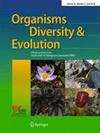The debris-cloaking larva of Catapotia laevissima and the origin of defensive strategies in Anamorphidae and other Coccinelloidea (Coleoptera)
IF 1.9
3区 生物学
Q3 EVOLUTIONARY BIOLOGY
引用次数: 0
Abstract
Abstract Debris-cloaking, a method of concealment with material collected from the environment, has evolved repeatedly with the purpose of avoiding detection in adults or immatures of various invertebrates including beetles. Fungus beetles in the family Anamorphidae (Coccinelloidea) are small-sized spore feeders of predominantly surface-dwelling habits. Debris-cloaking has been reported only for two genera in the family and nowhere else in Coccinelloidea. Here we report debris-cloaking behaviour in larvae of the Neotropical beetle genus Catapotia , describe its larvae, and compare it to confamilials. We summarise the knowledge on the defensive mechanisms and the natural history traits for members of the coccinellid group of Coccinelloidea. Possible evolutionary origins for the defensive mechanism are reconstructed on the basis of available phylogenetic hypotheses. Groups containing species with a larger body size also have a higher number of defensive strategies in larvae and adults; these include members of Endomychidae and Coccinellidae that exhibit reflex bleeding, aposematic colouration, and gregarious behaviour. Debris-cloaking has likely evolved only once, in the comparatively small-sized Anamorphidae.

变形虫科及其他瓢虫总科残体幼虫及其防御策略的起源(鞘翅目)
摘要:碎片隐身是一种利用从环境中收集的材料进行隐藏的方法,其目的是避免包括甲虫在内的各种无脊椎动物在成年或未成熟时被发现。在变形科真菌甲虫(球菌总)是小型的孢子食用者,主要居住在地面的习惯。碎片隐匿只在该科的两个属报道过,在球菌总科中没有其他报道。在这里,我们报告了新热带甲虫属Catapotia幼虫的碎片隐身行为,描述了它的幼虫,并将其与同科昆虫进行了比较。本文综述了瓢虫总科瓢虫群成员的防御机制和自然史特征。在现有的系统发育假说的基础上,重构了防御机制可能的进化起源。体型较大的种群在幼虫和成虫中也有较多的防御策略;这些包括内生菌科和尾藻科的成员,它们表现出反射性出血、警示性着色和群居行为。碎片隐身可能只在相对较小的变形科进化过一次。
本文章由计算机程序翻译,如有差异,请以英文原文为准。
求助全文
约1分钟内获得全文
求助全文
来源期刊

Organisms Diversity & Evolution
生物-进化生物学
CiteScore
3.60
自引率
0.00%
发文量
56
审稿时长
>12 weeks
期刊介绍:
Organisms Diversity & Evolution (published by the Gesellschaft fuer Biologische Systematik, GfBS) is devoted to furthering our understanding of all aspects of organismal diversity and evolution. Papers addressing evolutionary aspects of the systematics, phylogenetics, morphology and development, taxonomy and biogeography of any group of eukaryotes, recent or fossil, are welcome. Priority is given to papers with a strong evolutionary and/or phylogenetic focus. Manuscripts presenting important methods or tools or addressing key theoretical, methodological, and philosophical principles related to the study of organismal diversity are also welcome. Species descriptions are welcome as parts of a manuscript of broader interest that strive to integrate such taxonomic information with the other areas of interest mentioned above.
 求助内容:
求助内容: 应助结果提醒方式:
应助结果提醒方式:


